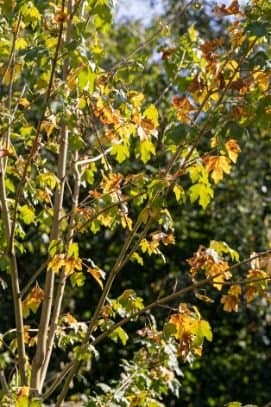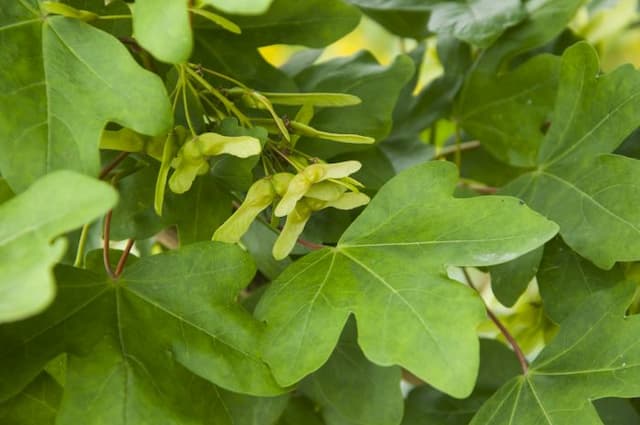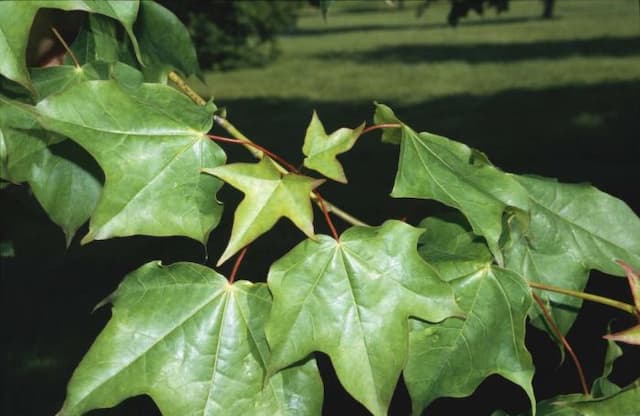Japanese Maple Acer palmatum 'Moonfire' (M)

ABOUT
The 'Moonfire' Japanese maple is known for its striking appearance, characterized by a unique leaf shape and striking coloration. The leaves of this cultivar are the classic palm-shaped or hand-like configuration that Japanese maples are known for, with multiple pointed lobes spreading out from a central point, resembling fingers. During different seasons, the leaves undergo a transformation in color. In spring, they emerge with a deep burgundy or purplish-red hue. As the season progresses towards summer, the foliage retains its rich color, providing a vivid contrast to the greenery in the garden. Then, as the cooler temperatures of autumn approach, the leaves take on a blazing display of reds, often mixed with orange and yellow tones, before finally dropping. The plant has a graceful growth habit, which is often well-branched and can have a layered look, creating a somewhat delicate appearance despite its bold colors. The bark on the branches and trunk is typically a smooth gray, providing a muted backdrop that further accentuates the brilliance of the leaves. The 'Moonfire' Japanese maple also produces small flowers in the spring, which can be a modest red or purplish, adding an additional layer of interest to its seasonal display. Over time, the tree may also bear small, winged seed pods called samaras, which start out red and become tan as they mature. These small ornamental features complement the overall aesthetic of the tree without detracting from its foliage, which is the primary decorative feature.
About this plant
 Names
NamesFamily
Sapindaceae
Synonyms
Japanese Maple, Moonfire Japanese Maple
Common names
Acer palmatum 'Moonfire'
 Toxicity
ToxicityTo humans
The Japanese Maple is generally not considered toxic to humans. There are no significant toxic effects reported for the Acer palmatum 'Moonfire' when ingested by humans.
To pets
Japanese Maple, including the 'Moonfire' variety, is not known to be toxic to pets. Ingesting parts of the plant typically does not result in poisoning or exhibit symptoms associated with toxic ingestion in animals such as cats and dogs.
 Characteristics
CharacteristicsLife cycle
Perennials
Foliage type
Deciduous
Color of leaves
Mixed
Height
15-25 feet (4.5-7.6 meters)
Spread
10-20 feet (3-6 meters)
Plant type
Tree
Hardiness zones
5-8
Native area
Japan
Benefits
 General Benefits
General Benefits- Aesthetic Appeal: The 'Moonfire' Japanese Maple is known for its beautiful purple-red foliage that adds a dramatic touch to any landscape.
- Year-round Interest: It offers visual interest throughout the seasons with its spring blossoms, summer leaf color, and vibrant fall foliage.
- Size: It is relatively small in size, making it suitable for smaller gardens or spaces where a full-sized tree would be too large.
- Shade Tolerance: This cultivar can tolerate partial shade, allowing it to thrive in a variety of garden locations.
- Low Maintenance: Once established, it requires minimal care besides occasional pruning and watering, making it ideal for busy gardeners.
- Cold Resistance: The 'Moonfire' Japanese Maple can tolerate cold temperatures, making it suitable for many climates.
- Attracts Wildlife: It can attract birds and other wildlife to the garden, providing a habitat and natural beauty.
- Can Be Container Grown: Its small size also allows it to be planted in a container, offering flexibility in garden design and the option for those with limited space.
 Medical Properties
Medical PropertiesThis plant is not used for medical purposes.
 Air-purifying Qualities
Air-purifying QualitiesThis plant is not specifically known for air purifying qualities.
 Other Uses
Other Uses- Photography: Japanese Maple 'Moonfire' is popular among photographers for its striking purple-red foliage, which provides a dramatic backdrop or focal point.
- Art inspiration: Artists may use the unique coloration and structure of Japanese Maple 'Moonfire' leaves as inspiration for paintings, drawings, or textile designs.
- Bonsai: This variety of Japanese Maple can be cultivated as a bonsai, offering a miniature version of its majestic appearance for collectors.
- Seasonal celebrations: Its fiery autumn color makes it a symbolic plant for fall festivals or garden displays celebrating the change of seasons.
- Culinary decoration: Although not traditionally edible, leaves of the Japanese Maple 'Moonfire' can be used as a non-toxic decorative garnish for upscale culinary presentations.
- Bioindicator: Like other maples, Japanese Maple 'Moonfire' can be used as a bioindicator for soil pH and overall soil health, as its growth and coloration are affected by soil conditions.
- Landscape architecture: The plant is used in landscape architecture to create focal points or to add vertical structure to garden designs due to its impressive height and form.
- Woodworking: While not commonly used, the wood of Japanese Maple 'Moonfire', being hard and dense, could potentially be used in fine woodworking for small decorative objects.
- Education: This plant can be used in educational settings to teach about botany, horticulture, and the importance of plant genetics and diversity.
- Seasonal art installations: The stark beauty of the tree, especially in autumn, can be incorporated into outdoor art installations and garden sculptures.
Interesting Facts
 Feng Shui
Feng ShuiThe Japanese Maple is not used in Feng Shui practice.
 Zodiac Sign Compitability
Zodiac Sign CompitabilityThe Japanese Maple is not used in astrology practice.
 Plant Symbolism
Plant Symbolism- Beauty and Elegance: With its delicate foliage and smooth bark, the Japanese Maple 'Moonfire' represents aesthetic beauty and grace, making it a symbol of elegance in the plant world.
- Change and Transition: The leaves of Japanese Maple 'Moonfire' undergo a dramatic change through the seasons. This characteristic embodies the nature of change and the graceful acceptance of life's transitions.
- Peace and Serenity: The Japanese Maple 'Moonfire' adds a sense of calm to any garden space. Its serene appearance provides a symbolic reference to peace and inner tranquility.
- Longevity and Strength: Despite its delicate appearance, the Japanese Maple 'Moonfire' can live for many years. It is often associated with endurance, longevity, and strength through adversity.
 Water
WaterJapanese Maple 'Moonfire' prefers consistent moisture with a deep watering once a week, especially during dry spells. It's best to water the tree with about 10 gallons each time, depending on the size and conditions, such as heat and soil drainage. Ensure the water penetrates deeply into the soil to encourage the roots to grow downwards rather than staying surface level. During the hottest parts of summer, you may need to water twice a week. It's important not to overwater, as Japanese Maples do not like to be in waterlogged soil.
 Light
LightThe Japanese Maple 'Moonfire' thrives in partial shade to full sun. A spot that offers morning sunlight with protection from harsh afternoon rays is ideal. This helps prevent the leaves from scorching. If the plant is young, it may require more shade until it is well-established.
 Temperature
TemperatureJapanese Maples like 'Moonfire' prefer temperate climates and can typically handle temperatures ranging from 20 to 85 degrees Fahrenheit. They can survive in temperatures as low as -10 degrees Fahrenheit, but it's not ideal. For optimal growth, aim for a climate that does not regularly drop below 20 degrees Fahrenheit.
 Pruning
PruningPrune Japanese Maple 'Moonfire' to maintain its shape, remove any dead wood, and improve air circulation within the canopy. Pruning is best done in late winter or early spring before new growth starts. Light pruning can be done any season except during autumn to avoid stimulating new growth that won't harden off before winter.
 Cleaning
CleaningAs needed
 Soil
SoilJapanese Maple 'Moonfire' thrives in well-draining soil enriched with organic matter, with a slightly acidic to neutral pH level around 5.5 to 7.5. A soil mix that includes garden loam, compost, and volcanic rock or perlite can offer proper drainage and nutrient retention.
 Repotting
RepottingJapanese Maple 'Moonfire' should be repotted every two to three years to refresh the soil and encourage healthy growth, with larger specimens requiring less frequent repotting.
 Humidity & Misting
Humidity & MistingJapanese Maple 'Moonfire' prefers moderate humidity levels but is adaptable to the typical outdoor humidity in its growing zones.
 Suitable locations
Suitable locationsIndoor
Bright spot, no drafts, cool winter temps.
Outdoor
Sun to part shade, protect from strong winds, mulch.
Hardiness zone
5-9 USDA
 Life cycle
Life cycleThe Japanese Maple 'Moonfire' (Acer palmatum 'Moonfire') begins its life as a seed, which typically germinates in spring after stratification, which is a period of cold treatment to break dormancy. Once sprouted, the seedling goes through a juvenile phase, where it slowly develops a root system and foliage but has not yet matured to reproduce. As it enters the vegetative stage, the sapling grows more vigorously, producing its characteristic palmate leaves that have a deep red or purple hue in this cultivar. The reproductive stage comes when the tree is mature enough to produce flowers, typically after several years; the small, red to purple flowers are followed by winged samaras (seed pods) that disperse in the wind. During its adult phase, which can span several decades, the tree goes through annual cycles of growth, flowering, and seed production, maintaining its ornamental foliage which transitions to a striking fiery red in autumn. In the final stage of its lifecycle, the tree will eventually decline due to age, environmental factors, or disease, at which point it ceases to produce viable seeds and will eventually die.
 Propogation
PropogationPropogation time
Late summer to early autumn
Propogation: The Japanese Maple 'Moonfire' is most commonly propagated through grafting, a method where tissues from one plant are inserted into those of another so that the two sets of vascular tissues may join together. This technique is typically performed in late winter or early spring before the bud break when the rootstocks are dormant. A scion, which is a young shoot or bud from the 'Moonfire' maple, is cut with a diagonal section to increase the surface area that will fuse with the rootstock. The rootstock, usually a seedling of a less decorative but hardy maple variety, is prepared with a corresponding cut to accept the scion. The two pieces are then joined and securely fastened with grafting tape or a similar material. It is important to maintain a high humidity environment around the graft to encourage successful fusion and to keep the graft union above the soil level to prevent rot. Grafting not only reproduces the desired characteristics of the 'Moonfire' maple, but also combines it with the vigor and adaptability of the rootstock's root system.







![Freeman maple [Autumn Blaze]](/_next/image?url=https%3A%2F%2Fplants-admin.emdemapps.com%2Fimages%2Fplants%2F%2Fimages%2F604b575b84d87.png&w=640&q=75)

